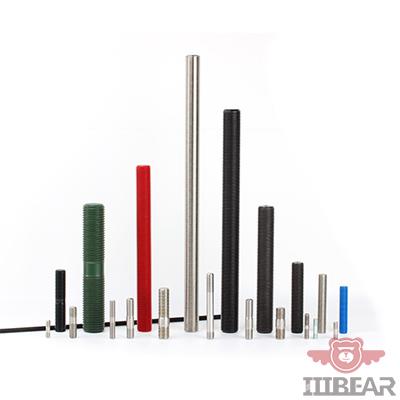Threaded rods are essential components in construction, manufacturing, and engineering projects. Choosing the right material for your threaded rods is critical to ensuring durability, strength, and performance. In this guide, we’ll explore the best materials for threaded rods, including stainless steel, galvanized steel, and other options, to help you make an informed decision.

What Are Threaded Rods?
Threaded rods, also known as stud bolts or all-thread rods, are long, straight metal rods with threading along their entire length. They are commonly used to fasten materials together, provide structural support, or act as anchors in various applications. The material of the threaded rod determines its strength, corrosion resistance, and suitability for specific environments.
Key factors to consider when selecting threaded rod materials include:
-
Tensile strength (the maximum stress a material can withstand while being stretched).
-
Corrosion resistance (the ability to withstand rust and chemical damage).
-
Durability (longevity under specific conditions).
-
Cost-effectiveness (balancing performance and budget).
Stainless Steel Threaded Rods: The Premium Choice
Stainless steel is one of the most popular materials for threaded rods due to its exceptional corrosion resistance and strength. It is ideal for applications in harsh environments, such as marine, chemical, and food processing industries.
Key Properties of Stainless Steel Threaded Rods
-
High corrosion resistance: Stainless steel contains chromium, which forms a protective oxide layer to prevent rust.
-
Strength: Grades like 304 and 316 stainless steel offer excellent tensile strength.
-
Hygienic: Easy to clean and maintain, making it suitable for food and medical applications.
Common Applications
-
Marine hardware (e.g., boat fittings and docks).
-
Chemical processing equipment.
-
Architectural structures exposed to weather.
Galvanized Steel Threaded Rods: Affordable and Durable
Galvanized steel threaded rods are coated with a layer of zinc to enhance corrosion resistance. They are a cost-effective alternative to stainless steel and are widely used in construction and outdoor applications.
Key Properties of Galvanized Steel Threaded Rods
-
Zinc coating: Provides a barrier against moisture and rust.
-
Moderate strength: Suitable for general-purpose applications.
-
Affordability: More budget-friendly than stainless steel.
Common Applications
-
Building frameworks and scaffolding.
-
Outdoor structures like fences and signs.
-
HVAC (heating, ventilation, and air conditioning) systems.
Other Materials for Threaded Rods
While stainless steel and galvanized steel are the most common, other materials are also used for specialized applications.
Carbon Steel Threaded Rods
Carbon steel is known for its high tensile strength and affordability. However, it lacks corrosion resistance and is often used in indoor or coated applications.
Brass Threaded Rods
Brass offers excellent corrosion resistance and electrical conductivity, making it ideal for electrical and plumbing applications.
Titanium Threaded Rods
Titanium is lightweight, strong, and highly resistant to corrosion. It is used in aerospace, medical, and high-performance industries.
How to Choose the Right Material for Your Threaded Rods
Selecting the best material depends on your project’s specific requirements. Consider the following factors:
-
Environment: Will the rod be exposed to moisture, chemicals, or extreme temperatures?
-
Load Requirements: What level of tensile strength is needed?
-
Budget: Are you looking for a cost-effective solution or a premium material?
-
Aesthetic Needs: Does the appearance of the rod matter (e.g., for architectural projects)?
For example, if you’re working on a marine project, stainless steel threaded rods are the best choice due to their superior corrosion resistance. On the other hand, galvanized steel rods are ideal for general construction projects where cost is a concern.
Installation Tips for Threaded Rods
Proper installation is crucial to ensure the longevity and performance of threaded rods. Here are some tips:
-
Use the right tools: Ensure you have the correct wrenches, nuts, and washers for installation.
-
Check alignment: Misaligned rods can lead to uneven stress distribution.
-
Apply thread locker: For added security, use a thread-locking adhesive to prevent loosening.
Conclusion
Choosing the best material for threaded rods is essential for the success of your project. Stainless steel offers unmatched corrosion resistance and strength, making it ideal for harsh environments. Galvanized steel provides a cost-effective and durable solution for general-purpose applications. Other materials like carbon steel, brass, and titanium cater to specialized needs.
By understanding the properties and applications of each material, you can select the right threaded rods for your specific requirements.

